 Joan Jonat, a China travel specialist at Protravel International based in Harrison, N.Y., loves working with clients who already know the country and are ready to visit areas they haven't seen previously.
Joan Jonat, a China travel specialist at Protravel International based in Harrison, N.Y., loves working with clients who already know the country and are ready to visit areas they haven't seen previously.
If they are experienced, she said, there is more flexibility, and "we will do some tourist sites and we will include something that is just fun."
"Just fun" for one family this June will be participation in the annual Shangri-La Horse Racing Festival in Yunnan province near the Tibetan border. The fest attracts people of many ethnic backgrounds who come to town for three days of singing and dancing in traditional costume.
Jonat has arranged for her clients to ride to the festival on horseback. In addition, as part of her service, she provided them with short biographies of their guides.
Planning that kind of trip is beneficial in a couple of ways: It generates referrals (99% of Jonat's China business is referred), and it reignites Jonat's interest in China.
She said she also is getting requests from her more adventurous clientele to visit Outer Mongolia on China's northern border and the Dunhuang Caves in the Gobi Desert of northwestern China. Nearly 500 caves outside the oasis town of Dunhuang harbor thousands of wall paintings and painted sculptures, created over a thousand-year period from the fourth to 14th centuries.
These requests are not typical. Jonat said most clients are interested in seeing the country's highlights first — "the iconic sites, the Great Wall, the terra cotta soldiers in Xian, things that represent China."
However, even with first-timers, she is seeing more opportunities to be creative.
For one thing, Jonat sees a trend toward longer trips. For example, more cruisers are staying longer to allow for a focused ground itinerary before or after the shipboard experience, she said.
When consulting about such trips, Jonat continued, it is important to evaluate the whole experience. For clients who book a cruise to gain downtime in the itinerary, she said there are other ways to relax, such as cooking classes or other special interests.
Jonat has sold China for 30 years but became a specialist only three years ago in a program run by Beijing-based Imperial Tours. She said she decided to emphasize the destination because "people are fascinated by it," and interest has increased "tremendously." Clients have been especially interested in the last eight years or so, she said.
Another Imperial Tours specialist, Tiffany Bowne, president of Lounge Couture in Los Angeles, said she became a specialist because "I felt it important to be able to sell it correctly."
She, like Jonat, finds that most clients want to begin by seeing the best known of China's sites. However, she said, they "are surprised how much there is to see and do when I start exploring options with them."
James Shillinglaw talks with Guy Rubin, managing partner of Imperial Tours, a Beijing-based upscale operator of customized small group and independent travel to China. Rubin discusses new destinations and top experiences in the country, as well as the emergence of a new, very modern and unexpected China for visitors.
http://www.travelpulse.com/an-interview-with-imperial-tours-guy-rubin.html
China remains one of the world’s most intriguing destinations – and one that Americans increasingly want to explore. To get an idea of the wide range of experiences this destination has to offer, we spoke with Nancy Kim and Guy Rubin, the husband-and-wife team who are managing partners of Imperial Tours, a high-end China tour operator based in Beijing but with an office in San Francisco. The company offers individually designed FIT and small group programs featuring unique experiences and destinations in China.
What do you believe higher-end American travelers are looking for in a trip to China today?
There’s a greater stress on authenticity than ever before. There’s an urge to break down the barriers to understanding what China means both in its present context and its probable effects on all of us 10 or 20 years down the line. We’ve noticed that in recent weeks and months the news media have also taken up the theme of how China will affect our future. It’s been a topic that has fired travelers for at least a year.
What are some of the unique experiences that Imperial Tours delivers for its guests?
We have a great variety of unique experiences. For those seeking authenticity, we have a democracy activist who left China after the Tiananmen Square demonstrations in 1989 who conducts a personal tour of Tiananmen Square and helps our guests contemplate what the role of Chinese government was at the time and where it might be going forwards. A very different way of discovering history is offered by our jazz tour of Shanghai, which takes place in the evening and takes you through the jazz bars and dance halls of the 1930s to end at a contemporary jazz venue. Our guide is a historian of the period and so jazz becomes a vehicle for looking at the dynamic society of those times, which is eerily reminiscent in some ways of today’s Shanghai. Apart from those, we have some classic family experiences, such as playing table tennis against the Olympic Champion or, at a lower price, against the coach who trained her when she was a high school student. For well-connected travelers, last year we were able to arrange access to the beautiful downtown mansion of a Shanghai socialite.
What is your customer demographic – and has it changed since you launched the company?
We have always focused on providing services to the high-end of the market. Our guests are well-educated and successful travelers in the 40-75 age range. Apart from many celebrities, business leaders and royalty, we are increasingly honored to work with a number of well-known institutions, such as the Museum of Contemporary Art of San Diego, Babson College, and the Victoria and Albert Museum of London on more specialized itineraries. In 2009, we launched China Escapades, a lower-priced FIT product, which does not include the western, Chinese speaking concierge for which we are known, (in addition to the guide and driver). This has proved successful and has made our FIT services accessible to a wider audience. That said, China Escapades is itself still a high quality product and our demographic has not changed substantially as a result of this launch.
What is the range of tour programs that you offer in terms of the number of customers on the trip and length of the program?
Our FIT business is all about customizing itineraries around the personality and interests of the traveling party. We are not about fitting clients into a mold and so we have no defining range or number for clients for FIT experiences. We will do a one person, three-week FIT and we will do a 120-person incentive for 10 days. Our criteria are that the travel experience be of a high quality, since this is the segment we know and understand and have been serving for over a decade. We also run scheduled group tours. These have a low maximum of 16 persons on a group and run from 10 to 13 nights, the shortest tour visiting what we term the “essential destinations” of Beijing, Xi’an, Guilin and Shanghai.
That’s a shame, given the striking venues those countries offer to incentive groups, Roach says. Per the common wisdom among planners, the most successful incentive programs give participants an experience they can’t easily get on their own, and a major way to achieve that is to stage a special event at a venue that is not accessible without certain “connections.”
What are some of the most popular but unusual destinations in China for your customers, and why?
Travelers of an academic bent very much enjoy Dunhuang. Located at the beginning of the Silk Road, this destination’s principle attraction are the Mogao Caves, which are 492 frescoed caves recording Central Asian history from the 4th to 14th centuries, as well as the inspiration for much Chinese figurative painting. This is a world-class site in an oasis town in the middle of the world’s second largest desert. Its popularity relies on the quality of its art, the originality and exoticism of its art and a sense of authenticity that is derived from traveling to an out of the way destination lacking the polish of the major urban centers.
What destinations in China do you think will become major tourist draws in the future that maybe the rest of the world doesn't know about?
The world is familiar with Lhasa primarily as a city associated with political disputes, but it’s also an amazing cultural capital. Now that the beautiful St. Regis has opened on the roof of the world, Lhasa has suddenly become a highly desirable exotic destination for the cultural adventurer. Since 1997 when we visited for the first time, we have long been fascinated with Lhasa and the Tibetan region and have made nearly 20 trips here. We find the scenery captivating and the local culture intoxicatingly colorful.
How easy is it to get around China today in terms of modes of transport?
One of the greatest successes of China’s transport industry has been the safety record of Chinese airlines over the last 15 or so years. The airline network has had to deal with fast-paced expansion and its subsequent demands. Little thought is given to the pressure this must have placed on the developing nation. We take it for granted, and yet in this area the Chinese aviation administration deserves the highest praise and respect. Although the road network has been well expanded, few travelers are going to drive the long distances required to follow a typical itinerary. Until recently, railway lines and carriage stock have lagged in investment. Over the last two to three years, the tables have been turned and investment in rail has increased exponentially. Recently, high-speed rail links connecting many popular destinations have sprouted all over the country. The Beijing-Shanghai link, for example, has reduced travel time from to five from 12 hours so that the train will be able to compete with air service.
How easy is it to operate a private tour operator today in China?
Imperial Tours was founded in 1999, and since that time we have always felt welcome in China. Given that our business is structured on the premise of our bringing foreign currency into China, this is not surprising. What has been more challenging is changing the mores of the travel industry to operate according to our standards and expectations. For example, we operate no shopping tours, meaning our guests are not taken to commission-paying stores or restaurants. When we started operations this was unheard of and we encountered great resistance in implementing such novel practices. Even though 10 or so years later, the industry is more open to such concepts, the Chinese travel industry still tends strongly towards a pattern suitable for high-volume mass operators rather than niche high quality operators. Joining Virtuoso as an on-site in 2002 was a great boon followed by our accession to Signature’s network as a preferred supplier in 2006.
What do you see as your biggest challenges in promoting China in the U.S.?
What is marvelous about the U.S. as a free and permeable society is how open it is to outside cultures. The general tenor of opinion towards China is increasingly positive and this trend chimes well with the forecasts we are regularly shown predicting explosive growth in the inbound China market. Against this backdrop of increased interest, our greatest challenge is in raising the level of knowledge about China around the world. While most people will think of the Great Wall, Terracotta Warriors and Yangzi River with reference to China, few would quickly associate the Himalayan Mountains, the tropical South China Sea islands or one of the world’s largest deserts. There are also destinations with stunning landscapes in southern China or bafflingly advanced bronze technology on the central plains created at the time the pyramids were being built. Imperial Tours’ China Expert program, a four-part training course that we run for North America agents in November every year, aims to address this issue and open agents’ eyes to out-of-the-ordinary activities available to families, couples and travelers across China’s various luxury destinations. To register for this training, travel agents are encouraged to contact reservations@imperialtours.net.
For more information on Imperial Tours, visit www.imperialtours.net.
This article by Imperial Tours’ founder about the tribes of Guizhou is for cultural informational purposes only. Imperial Tours does not offer services to these destinations as luxury faciltiies are not available.
By Guy Rubin
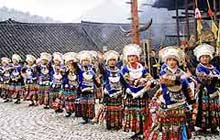 As cranes and bulldozers proliferate like ants across China, depositing cities and highways in their hammering trail, now is the time to venture inland in search of the more traditional side of China. In a vast crescent of land, curving from Guilin’s moonscape through the jungles of Xishuangbanna to the Tibetan plateau in the north west, reside many of China’s ethnic minorities. From the Dong to the Yi to the Bai, each minority, with its own distinct lifestyle, culture and mythology embodies a unique and refreshing vision of the world.
As cranes and bulldozers proliferate like ants across China, depositing cities and highways in their hammering trail, now is the time to venture inland in search of the more traditional side of China. In a vast crescent of land, curving from Guilin’s moonscape through the jungles of Xishuangbanna to the Tibetan plateau in the north west, reside many of China’s ethnic minorities. From the Dong to the Yi to the Bai, each minority, with its own distinct lifestyle, culture and mythology embodies a unique and refreshing vision of the world.
North-west of Guilin, Guizhou, a rarely visited, landlocked province is an anthropoligical treasure trove. Its poor farmland and geography, discouraging the interest of powerful neighbours, are home to 13 of China’s 60 officially recognized ethnic minorities. The tawdry provincial capital of Kaili, a five hour train ride east of Guiyang, provides a good base for explorations of the surrounding Miao villages.
Courtship, Miao style
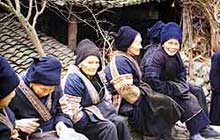 On our arrival at Langde, south-west of Kaili, visitors were already being conducted into the village to participate in its New Year festival. At each turn in the zig-zagging path that climbed to the hillside village’s stone portal, children and beautifully bedecked local women were on hand to offer celadon-colored cups of the local wine. Their heads held rigid beneath ornate silver head-dresses, their bodies delicately poised in intricately embroidered, traditional costumes, they appeared like guardian angels at the gates of heaven. As I tipped one of the proffered ceramic cups back, glancing beyond its dark outer rim at the silver-framed, smiling child before me, I wondered how long this idyllic custom might continue.
On our arrival at Langde, south-west of Kaili, visitors were already being conducted into the village to participate in its New Year festival. At each turn in the zig-zagging path that climbed to the hillside village’s stone portal, children and beautifully bedecked local women were on hand to offer celadon-colored cups of the local wine. Their heads held rigid beneath ornate silver head-dresses, their bodies delicately poised in intricately embroidered, traditional costumes, they appeared like guardian angels at the gates of heaven. As I tipped one of the proffered ceramic cups back, glancing beyond its dark outer rim at the silver-framed, smiling child before me, I wondered how long this idyllic custom might continue.
My thoughts were interrupted by the warbling notes of lusheng pipes emanating from the stilted wooden homes. These hand-held, reed pipes, used by the Miao minority, have become the generic term for their courtship festivals. We hurried towards the music’s source; its wavering melody, enlivening the still, damp air, teased us through the village’s labyrinthine, stone-paved pathways. Skirting a moss-covered pond with a breath-taking view over the river, we eventually arrived at the main square.
Stepping onto the “Flower Ground”, also translated as the “choosing a lover ground”, we were overwhelmed by the bustling activity before us. This cobble-stone patterned courtyard, tucked in on three sides by beautiful, tiled houses and overlooking a low valley on the fourth, was a kaleidoscope of color and sound.
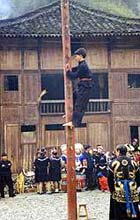 Dozens of elaborately clad girls and uniformed boys were crowding around each other. At a resolute, booming signal from a large bronze drum, the elderly folk, wearing dark robes with embroidered sleeves, guided their grand-children (ethnic minorities are exempt from the one child policy) to a nearby stone wall, clearing the square. They chattered amongst themselves as the boys, once more playing the lusheng pipes, led the girls through a delicate, shuffling dance of graceful bows and dainty hops.
Dozens of elaborately clad girls and uniformed boys were crowding around each other. At a resolute, booming signal from a large bronze drum, the elderly folk, wearing dark robes with embroidered sleeves, guided their grand-children (ethnic minorities are exempt from the one child policy) to a nearby stone wall, clearing the square. They chattered amongst themselves as the boys, once more playing the lusheng pipes, led the girls through a delicate, shuffling dance of graceful bows and dainty hops.
Although the mood is gay and the occasion light-hearted, there is little aimlessness about these courtship activities. Their goal is to bring together boys and girls of marriageable age for matchmaking. If a particular boy’s looks and dancing make some maiden’s heart palpitate and her knees go wobbly, tradition dictates that she should place a ribbon around his neck. If the boy is similarly smitten, he may show his interest by returning the talisman to her later in the day.
It appeared that the greatest risk to any ensuing relationship stemmed from the macho stunts the boys perform at the end of the festival to prove their mettle. Having walked across hot coals and lain on a bed of nails, one brave Miao youngster approached the tall pole in the center of the square. During the subsequent drum-roll, we noticed that the rungs punctured into this pole were actually comprised of up-turned, dagger blades – which the boy now circumspectly ascended. A villager informed us that the trick to doing this consists in not nudging your hands or feet sideways as you lay them on the blades. And if you do? In response, our interlocutor resignedly shrugged his shoulders.
As we were ambling out of this picture-book village, serenaded by the lilting tune of the pipes, we were loathe to acknowledge the undeniable influences of the modern world on this age-old festival. On a superficial level, many of the elaborate head dresses, used to differentiate women from various villages, were being replaced by a tacky assembly of bath towels held in check by plastic combs. More significantly perhaps, we observed a marked absence of young men in the crowd. A villager confirmed that many had left for the towns in search of work. The farms were barely surviving, he claimed, only kept going by the irregular remittances of these migrant workers.
An Inter-Village Bull-Fight
The very next day however, we drove by a terraced hill bedecked with such young men and their bulls. Leaping out of our minibus, we rushed past food stalls to see what was going on. It was an inter-village bull-fighting competition. And it was being conducted in deadly earnestness. While the men huddled excitedly around the bull-fighting ground, women and children sat disinterested, high on the hill.
Unlike their Spanish equivalent, these bullfights do not pit man against beast, but bull against bull. Having been drawn opposite each other, metal-tipped horn to metal-tipped horn, their oil-rubbed flanks glistening under the low, flat skies, it is a matter of seconds before the bulls’ heads lower and, with a crack, they aggressively ram each other. With their horns locked and their muzzles scraping along the kicked up turf, the bulls embark on a titanic struggle. Since each bull’s character is as varied as its physique, every fight, incorporating different fighting strategies, is absorbingly unique – the winner being decided in one of two ways. Either a team of judges selects a champion or else every so often one of the bulls flees, often into the nearby crowd, scattering exhilarated onlookers in all directions.
In the excited tension, articulated on every male face in the valley, there was no doubting the enduring fascination and enjoyment of this entertainment.
Ethnic Opera
More surprising perhaps, given the general disinterest of city dwellers, is the popularity of “dixi” or ground opera at a Bouyei village we visited. This local strain is derived from Han opera, brought to the region by soldiers from Nanjing during the Ming dynasty.
Glamorously dressed singers were surrounded by the whole village, who sat enraptured for the whole of the five hour performance. In fact, so enthusiastic was their reception, that the singers were called upon to repeat favorite arias for different sections of the crowd. For us, nonaficionados, it was as fun to watch the antics of the audience and chat with the villagers as it was to listen to the opera.
Guizhou’s relative poverty continues to shield its indigenous peoples from the encroachment of China’s predominantly coastal consumerism. Those travellers prepared to venture far from Guizhou’s main roads can still be rewarded with cultures who seem to have escaped the claws of time. As the incipient Chinese tourist industry gathers momentum however, expect the innocent spirit of these fragile societies to be compromised by the easy lure of the tourist dollar.
For more information, pick up a copy of “Guizhou, Southwest China’s Mountain Province,” by Gina Corrigan (Passport Books, ISBN I 0-8442-9896-4)
July 2000, Chinanow.com
![]() Before the introduction of the engine, trackers were an indispensable feature of transport along the Yangzi. These river people battled daily with the river, providing the muscle to drag 40-100 ton vessels 1500 miles from Shanghai to Chongqing up a series of treacherous gorges and against a current of 6-12 knots. Mostly men, they worked like cattle for 12 hours a day, nine days at a time, to earn enough money to feed themselves poorly and every so often escape to an opium-fueled Elysium.
Before the introduction of the engine, trackers were an indispensable feature of transport along the Yangzi. These river people battled daily with the river, providing the muscle to drag 40-100 ton vessels 1500 miles from Shanghai to Chongqing up a series of treacherous gorges and against a current of 6-12 knots. Mostly men, they worked like cattle for 12 hours a day, nine days at a time, to earn enough money to feed themselves poorly and every so often escape to an opium-fueled Elysium.
There were two types of trackers, permanent and seasonal. The permanent trackers were based in local villages along the river. It was usually these that formed the basic crews of many junks. The seasonal trackers would hire themselves out at temporary shantytowns, set up where their need was greatest along the difficult gorge-strewn reaches of the Upper Yangzi, west of Yichang. The risk of storm, the potential for sudden changes in the river's water level, the avarice of ship owners and the charged, violent atmosphere to which this brutal lifestyle tended, introduced many additional, unseen risks into what was already dangerous work.
Commonly, trackers used long ropes to drag craft upriver. Four-inch wide braided, bamboo hawsers were attached to the boat's prow. As many as 400 trackers would hitch themselves in a long series to these and, shoed in straw slippers, would listen for drum signals to direct the progress of their haul. Along some stretches one foot wide "tracker paths", the charitable donation of a wealthy merchant, had been carved into the cliff. Since these had to take into account the frequent change in water level, these tracks could be as high as 300 feet above the river. You might look out for them as you proceed through the gorges. Often however, trackers while heaving their load, had to dexterously pick their way across various-sized boulders lying along the shoreline. If a cliff stood in their way the trackers, having boarded the craft, by inserting hooked poles into nooks in the rock face, would inch the boat laboriously along the cliff.
Descent of the river, though less onerous, was equally dangerous. Trackers would now work mainly in the boat. The bow-sweep, used to direct the boat, demanded fifteen men, while each of the oars ten. In descent, far less important than propelling the boat forwards was maintaining a safe position in the fast-flowing current. For this, at particularly dangerous rapids, skilled captains were on hire, who specialized in negotiating particular set of rapids.
Many trackers drowned in the raging torrents of the Yangzi. Many more suffered from work-induced strains, hernias and other illnesses. We pay tribute to them.
by Wendy Perrin
 Twenty years of interviewing travel agents and tour operators for “The Perrin Report” and other Condé Nast Traveler articles has given me a well-thumbed directory of the most trusted insiders – people who offer the best combination of specialized knowledge (based on firsthand travel experience), local connections, user-friendliness, and value for your dollar.
Twenty years of interviewing travel agents and tour operators for “The Perrin Report” and other Condé Nast Traveler articles has given me a well-thumbed directory of the most trusted insiders – people who offer the best combination of specialized knowledge (based on firsthand travel experience), local connections, user-friendliness, and value for your dollar.
Each year my team and I evaluate hundreds of new applicants to this list, and only a small number make the cut. Our recommended specialists have undergone a rigorous screening process that begins with a 47-question application with sample itineraries and client references, then continues with phone interviews and, in most cases, road-testing by Conde Nast Traveler staff. Those who unnecessarily book trips through pricey middlemen (as opposed to directly with local hotels and suppliers) or use on-site contacts that charge exorbitant rates are disqualified. Even so, the travel specialists who make the grade can be expensive…
Guy Rubin, Imperial Tours, Beijing
There’s no danger of being taken advantage of by the more pernicious elements of China’s tourism machine when you’re traveling under Rubin’s wing: no dining in Government-run restaurants, no shopping in sub-par state-run souvenir stores (most companies’ guides get kickbacks for steering travelers to them). That’s because all of Rubin’s clients are accompanied by a local guide and a Western escort. Although any snags are ironed out immediately by your at-hand troubleshooter, this means that you’re committed to traveling with an entourage—thus the steep price (888 888 1970).
©Sept 2009 Condé Nast Traveler
FOR IMMEDIATE RELEASE
May 26, 2009
Contact :
Margot Kong
Imperial Tours
(888)888-1970
margot@imperialtours.net
Imperial Tours Gives Back
How Ultra-Luxury Travel Helps Children in China
SAN FRANCISCO, Ca – (May 26, 2009) – Imperial Tours continues a tradition of social contribution by dedicating a playground in rural China to the Virtuoso agents attending
their On-site Table at the Travel Mart in Las Vegas. A memorial stone commemorating the
expansion of a school playground was recently presented by the headmaster of the rural
school in China to thank the luxury agents seated at Imperial Tours' On-site table at the
2008 Virtuoso Travel Mart. This builds on the first phase of the project in which former
guests, travel agents and Imperial Tours contributed to the design, drainage and
construction of a large, new playground area.
"It is great to remember the good that our industry does, not just in providing manifold
employment opportunities to local economies and investing in out-of-the-way areas that
might not otherwise have a hopeful economic future, but also in charitable acts like this, "
says Guy Rubin, Managing Partner of Imperial Tours.
The company has offered responsible travel since 2002, when Nancy Kim, co-founder of Imperial Tours, spearheaded a fundraising ball for the daunting challenge of enrolling 700,000 children into the China Special Olympics program. The fund-raising ball has since turned into an annual event, raising more than $330,000 for Special Olympics China. Imperial Tours also supports the affiliated Best Buddies program, a nonprofit organization dedicated to enhancing the lives of people with intellectual disabilities by providing opportunities for one-to-one friendships and integrated employment.
Imperial Tours' social contributions span the Yunnan and Guangxi provinces, supporting schools in Guilin and Lijiang. Activities have included funding the tuition and educational expenses for underprivileged children and providing desks to a rural school. Itineraries with visits to Shangri-La or Lhasa provide immediate and direct assistance to local communities by utilizing ground-handling services run entirely by Tibetans.
With so many companies using a "sustainable" marketing spin, it can be difficult to find those pro-actively helping local communities while enriching the traveler. Long before it was chic for companies to give back, Imperial Tours has always offered its guests a chance to participate in its investment in rural communities and the educational development of China's most disadvantaged children.
ABOUT IMPERIAL TOURS
Imperial Tours is the leading luxury tour operator based in China offering luxury set-departure and private tours, combining local expertise with the high levels of service and quality expected by sophisticated Western travelers. Imperial Tours has first-hand knowledge of world-class hotels and restaurants as well as the history, culture, arts, and little-known exclusive destinations within China. Founded by Westerners in 1999, Imperial Tours has offices in Beijing, San Francisco, Frankfurt and the UK. For more information, visit www.imperialtours.net or call (888)888-1970.
The World's Most Populous Nation+ 1
China News February, 2009
|
Imperial Tours' last newsletter was published before the birth of Adan, Nancy and my first son. It's appropriate then that this one, the first of a quarterly series, is being sent just days after the birth of our second son, Lev.
This newletter features:
Closing The Gap Between Continents – Announcing the Travel Alliance, an association of top suppliers
A Room with a View – Imperial Tours' evaluation of the top hotels in Beijing and Shanghai
Taking a Bow – Imperial Tours honors its top travel consultants of 2008
In The Dream Business – dates of our upcoming FAMs and regular departure group tours
US Fed Guarantees Imperial Tours' Clients' Funds – Find out how We Keeps Client Funds Secure
Face Off With A Champ – Play tabletennis with Zhang Yi Ning, reigning Olympics Champion, and other champions & coaches
The Travel Alliance – Closing The Gap Between ContinentsThe Travel Alliance is an association of award-winning destination specialists, recognized internationally for their enlightened trip planning, insider access and exceptional guides. Leveraging the talents of like-minded tour operators across many countries, The Travel Alliance dedicates itself to delivering tailor-made itineraries of uncompromising quality. We invite only the best of our peers to join the alliance, and then constantly monitor performance to ensure its continued excellence. As separate companies within individual countries, we have changed the way people travel. As a world-wide travel alliance, we offer you the same expertise across the globe. When life calls…the world awaits. Please click on any company logo below to visit each company's website for further details.
A Room With a View: Finding The Perfect Accommodation In preparation for the 2008 Olympics in Beijing and the 2010 Expo in Shanghai, the landscape of these two metropolises have been revolutionized with a panoply of new openings from the stylish quintessentially Chinese characteristics of the Aman Summer Palace in Beijing, to the characteristically stylish breeding of the Park Hyatt in Shanghai. Which should you select for your clients? Opting for a well-known brand guarantees a certain quality, but for some clients there is little value-added in securing a chain hotel which they could have selected for themselves anyway. Such clients seek excellence, and with such a broad range of hotels available in many major cities, this is defined as matching the right client to the right hotel. To make informed recommendations to your clients, inquire about the top properties here.
|
Taking a Bow – Imperial Tours Honors Its Top Travel Consultants of 2008
Imperial Tours takes great pleasure in thanking all its sales partners for supporting our business in 2008 to make it our most successful to date. In particular, we are extremely grateful to the travel consultants below – our 2008 Travel Agents of the Year. Special plaudits go to Karin Hansen and Stuart Markus who also both featured on this list in 2007.
|
"Best tour experience I ever had."
– Margot Halperin, Bee Kalt Travel |
Michele Cook (Mansour) and Karin Hansen (Frosch)
We thank you with signed copies of Jereme Leung's cookbook, New Shanghai Cuisine.
|
"I have traveled often with exceptional tour companies but have never had an experience equal to this. Exceptional in every way!" – JanVerhage
|
Did you know that Imperial Tours now offers over 40 nights of luxury travel experiences throughout China?
Besides our two regular FAM trips and well-known FIT services, we also arrange regular departure small group tours, perfect for travelers who enjoy meeting like-minded people as they travel in style. Like all our trips, the group tours offer unparalleled value:
FAM Tour
|
"The food was amazing – I have the feeling the places you took us were not exactly typical. But as long as you take our clients to those places – that's what matters."
– Sharon Elsen, Cardoza-Bungey Travel |
We would love for you to join a FAM trip! How else can we open your eyes to how unbelievably amazing and interesting China was in its imperial past and is today – leading the world in some disciplines and way behind in others? By hook and by crook, sometimes depsite itself, this country is going places, and you won't find out how and why by reading the papers or watching tv. Come here, enjoy it and then sell it to your clients. Experience and understand:
Our next 11-night FAM trip to Beijing, Xi'an, Guilin, and Shanghai begins on March 14. For availability information, please inquire with Margot Kong in San Francisco.
Imperial Tour
|
"Laurie and I travelled 110 days last year with some of the best respected tour companies in the world. Imperial Tours was "THE BEST" company we travelled with in planning and executing the trip. Great job!!" – Kenneth Goodman
|
Our benchmark tour, this 13-night itinerary covers the essential destinations in China. Our tours are limited to 20 people, VIP services are standard, and include such features as access to off-limits palaces in the Forbidden City, and more.
Upcoming Imperial Tours are April 14-27 and May 5-18. Both of these tours are guaranteed departure dates. Please see the Imperial Tour itinerary page for more 2009 dates.
Special in 2009: our July Imperial Tour will feature a unique Shanghai skyline breakfast-viewing of the longest Solar Eclipse for the next 130 years. For additional information on the eclipse, please click here.
Family Tour
Look at the photos below to choose a unique experience for your family!
 |
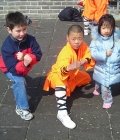 |
 |
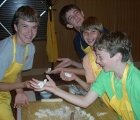 |
 |
 |
Our families explore landmarks at a pace that won't tire the young. The Family Tour's featured activities, such as Peking Opera-style face painting or a kungfu demonstration, will pique the adventurous, while optional spa treatment or shopping can delight any generation. Of course there is more to travel than just fun and games, and our family tour provides an excellent educational opportunity to learn about China.
This year's Family Tour begins on August 7, 2009. Find out more details on our Family Tour itinerary page.
For more information or availability on the above tours, Margot Kong in San Francisco is ready to take your questions.
In these uncertain times, it is reassuring to know that clients' funds are as safe as the US Fed. Imperial Tours together with many of its leading vendors, such as the St. Regis Hotel in Beijing and the Grand Hyatt Hotel in Shanghai, have participated in the Travel Funds Protection Plan (TFPP) operated by National City Bank since 2001. Recognized for its consumer protection benefits by ASTA and such strictly enforced Seller of Travel laws as that of California, TFPP can claim to be one of the most secure consumer protection plans in the world. 100% of clients' funds are deposited in separate escrow accounts – there is a separate account for each payee – and are held there until 5 days after the tour has finished. Whilst the funds are held, they are guaranteed in their entirety by the US Fed!
5 days after the tour has finished, on condition that all services were supplied, vendors are paid and the remainder of the funds pass into Imperial Tours' operating account. For further information on TFPP, please click here.
Imperial Tours invites you to play ping pong with the world's reigning Olympic and World champion Zhang Yining. Ms. Zhang, a 27 year-old Beijing native, caught the world's attention during the 1999 World Table Tennis Championship. Since then, she's been at the top of the sport and has won over 20 gold and silver medals. She has encountered stiff competition across the globe, but has yet to witness your nephew's "overhand double-cross-slam" that he perfected in the basement last summer.
Playing ping pong with the best of the best is an example of specialized activities we call "Imperial Moments." Imperial Tours can supplement any FIT itinerary with a variety of such unique experiences depending on your specific interests. Want to delve deeper into the Forbidden City? Why not explore it with a Sotheby's Expert. Trying to get into better health? What about a private Tai Chi lesson from a sixth-generation master.
|
"Andy was the perfect China host, we really liked him hugely and he was endlessly thoughtful and interesting and took real care to ensure we got the most out of our time there." – Baroness Kate de Rothschild
|
Looking for the perfect armoire? How about shopping with an antique dealer. Curious about doing business in China? Learn about the pitfalls from the first investment banker to come to China. Even when clients might have unusual requests, we'll do everything we can to accommodate them (In 2008 a guest was interested in nuclear power; and we arranged a tour of a rare pebble-bed facility for him!).
Because our operations are China-based, Imperial Tours has the insider-knowledge and flexibility that allows our guests more personalized experiences in China. For additional details on our special activities, feel free to contact Margot Kong in San Francisco or Kent Milne in Poole, England with your questions.
As the luxury market regains its foothold, China will be sure to extend its relevance as a destination for luxury travelers. Apart from the stunning organization of the Beijing 2008 Olympics, or the increasing significance of this industrious nation to the world economy, or the continous development of new destinations, better hotels and more sophisticated restaurants, there is the unchallenged value that China brings to the table.
If business is slow, why not use this time to learn more about China? If you haven't yet been on one of our FAM trips, treat yourself, surprise yourself, enjoy yourself.
Sending best regards,
Guy Rubin
Managing Partner of Imperial Tours
FOR IMMEDIATE RELEASE
November 18, 2008
|
Contact : Heather Caufield |
Amy Benson |
 |
Dumplings & Dynasties
The James Beard Foundation Celebrates the Evolution of Modern Chinese Cuisine with Annual Gala Dinner/Auction and Two-Day Conference.
New York, NY (November 18, 2008) – The James Beard Foundation celebrated the evolution of modern Chinese cuisine last Thursday at Dumplings & Dynasties, a gala dinner and fundraising auction. The exceptional banquet of modern Chinese fare prepared by guest chefs from China and North America for over 240 people at The Edison Ballroom raised funds for the James Beard Foundation. Following the gala, the Foundation hosted a two-day conference featuring experts on the food and culinary culture of China.
The evening began with a dim sum reception created by Terrence Chan of Lai Wah Heen at the Metropolitan Hotel in Toronto. The banquet dinner was prepared by Chen Jun of Peninsula Restaurants in Shanghai; Richard Chen of Wing Lei at Wynn Las Vegas; Chow Chung of Chow Chung Restaurant in Hong Kong; JBF Award Winner Susanna Foo of Susanna Foo in Philadelphia; Susur Lee of Madeline's and Lee in Toronto and Shang by Susur Lee in New York City; Patrick Lin of Metropolitan Hotels in Toronto and Vancouver; Terrence Chan and Ken Tam of Lai Wah Heen at the Metropolitan Hotel in Toronto; with support from Joe Ng of Chinatown Brasserie in New York City. Wine and beverage pairings for each course were chosen by guest sommelier Joshua Wesson. The event's décor was created by Marc Wilson of Marc Wilson Design.
Notable guests included Ming Tsai, B.D. Wong, Vivienne Tam, Daniel Boulud, Joe Bastianich and Gael Greene. The event featured once in a lifetime live auction packages, including an auction lot sold for $26,000 that included dinner for 12 at Shang by Susur Lee with Champagne pairings by Nicolas Feuillatte and Oysters from Taylor Shellfish Farms of Shelton, Washington, plus a dazzling pearl and diamond necklace from Mikimoto for the hostess. The top selling package of the evening was a seven-day gourmet excursion for two to China, provided by Imperial Tours and courtesy of Valerie Wilson Travel with Delta BusinessElite airfare for two to Shanghai, which sold for $30,000. In all, the silent and live auctions raised more than $160,000 to support the James Beard Foundation's mission and programs.
The James Beard Foundation's 2008 Conference on Cuisine and Culture on Friday, November 14, and Saturday, November 15 featured a day of presentations, panels, and discussions with experts from around the world on a wide range of topics, followed by a day of experiential learning activities designed to give participants an opportunity for hands-on education.
Sponsors
The Dumplings & Dynasties events were sponsored by Delta Air Lines, Metropolitan Hotels, Lee Kum Kee, Saveur Magazine, Acqua Panna® Natural Spring Water, Mikimoto, S.Pellegrino® Sparkling Natural Mineral Water with cultural partners Asian/Pacific/American Institute at NYU and Asia Society, and event partners Astor Center, Chinatown Brasserie, Savory Productions and TMI Trading – Chef.
About the James Beard Foundation
Founded in 1986, the James Beard Foundation is dedicated to celebrating, preserving, and nurturing America's culinary heritage and diversity in order to elevate the appreciation of our culinary excellence. A cookbook author and teacher with an encyclopedic knowledge about food, James Beard, who died in 1985, was a champion of American cuisine. He helped educate and mentor generations of professional chefs and food enthusiasts. Today, the Beard Foundation continues in the same spirit by administering a number of diverse programs that include educational initiatives, food industry awards, scholarships to culinary schools, and publications, and by maintaining the historic James Beard House in New York City's Greenwich Village as a "performance space" for visiting chefs.
Guy Rubin, Imperial Tours, Beijing There's no danger of being taken advantage of by the more pernicious elements of China's tourism machine when you're traveling with Imperial Tours: no dining in government-run restaurants: no shopping in sub-par state-run souvenir stores(most companies' guides get kickbacks for steering travelers to them).That's because all of Rubin's clients are accompanied by a local guide and a Western escort. Although any snags are ironed out immediately by your at-hand troubleshooter, this means that you're committed to travelling with an entourage – thus the steep price (888-888-1970; $2,100).
©Aug 2008 Condé Nast Traveler